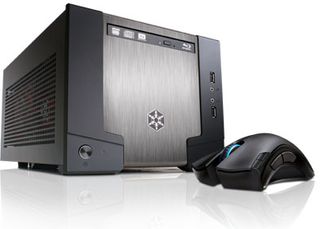Origin PC Millennium: 3-Way SLI And A 4.6 GHz Core i5
After a long hiatus, Tom's Hardware returns to consumer desktop reviews with Origin PC's Millennium. Can three GeForce GTX 660 Ti cards and an overclocked Core i5 handle gaming at 5760x1080? We want to know if this elegant box is worth its $3,000+ price.
CyberPower Baseline System And Benchmarks
Since this is the first desktop Tom’s Hardware has reviewed in quite a while (you can expect more soon), we don’t have a whole lot to compare the Origin Millennium build to. System builder CyberPower graciously sent us one of its more compact systems to serve as our new performance baseline.

A $918 configuration of the LAN Party Evo Mini with a single Nvidia GeForce GTX 550 Ti graphics card, our baseline system is in a different league than our test configuration of the Origin Millennium. It also sports the same Core i5-3570K CPU as the pricier Origin system, although not overclocked. The LAN Party Evo certainly can’t keep up with the Millenium, which costs three times as much. But it does give us some sense of the performance difference between a sub-$1,000 system and a build that’s north of three grand. However, there are advantages to running a single graphics card and not overclocking your CPU, as you’ll see later on in our power testing.
| CyberPower LAN Party Evo Mini | |
|---|---|
| Processor | Intel Core i5-3570K (Ivy Bridge), 4C/4T, 3.4 GHz Base Clock Rate, 3.8 GHz Maximum Turbo Boost, LGA 1155 |
| Motherboard | ASRock Z77E-ITX, Z77 Express Chipset |
| Memory | 8 GB DDR3-1600 (4 GB x 2) |
| Graphics | Nvidia GeForce GTX 550 Ti 1 GB |
| Storage | 1 TB SATA 6 Gb/s Hard Drive, 7,200 RPM |
| Cooling | Asetek 510LC 120 mm |
| Power Supply | SilverStone 600 W Power Supply |
| Chassis | SilverStone SG07B |
| Optical | 8x Slim CD/DVD burner |
| Operating System | Windows 7 Home Premium (64-Bit) |
| Price as Configured | $918 |
To get a well-rounded sense of how our baseline and review systems perform, our test suite includes a battery of CPU-centric tests borrowed from our CPU benchmark suite (HandBrake, iTunes, WinZip, and Photoshop CS 6), along with gaming tests that should be familiar to readers of our graphics card reviews (3DMark 11, World of Warcraft, Battlefield 3, Batman: Arkham City). We’re also testing the drive speed of the boot drive using Iometer, measuring both power efficiency as well as how loud the system is at idle and under load.
Stay On the Cutting Edge: Get the Tom's Hardware Newsletter
Join the experts who read Tom's Hardware for the inside track on enthusiast PC tech news — and have for over 25 years. We'll send breaking news and in-depth reviews of CPUs, GPUs, AI, maker hardware and more straight to your inbox.
Current page: CyberPower Baseline System And Benchmarks
Prev Page Origin Millennium: Inside And Out Next Page Benchmark Results: CPU And MultimediaAfter a rough start with the Mattel Aquarius as a child, Matt built his first PC in the late 1990s and ventured into mild PC modding in the early 2000s. He’s spent the last 15 years covering emerging technology for Smithsonian, Popular Science, and Consumer Reports, while testing components and PCs for Computer Shopper, PCMag and Digital Trends.
-
DarkSable So... no mention of the fact that you're paying for a lot of things you don't need? In it's head-to-head against the DIY rig, I'm noticing a LOT of parts that I wouldn't even consider spending extra money on.Reply
And they're getting those parts at a discount, so you're paying a lot of money for that tech line. -
EzioAs "This system’s starting price is a relatively modest $1,225. For that, you get a Core i3-2120 CPU, an AMD Radeon HD 7750 graphics card, and a 500 GB hard drive."Reply
Wow, talk about rip off... -
DarkSable Reply9539987 said:"This system’s starting price is a relatively modest $1,225. For that, you get a Core i3-2120 CPU, an AMD Radeon HD 7750 graphics card, and a 500 GB hard drive."
Wow, talk about rip off...
Haha, yeah. That's about what I spent for an i5-3570k and GTX 670. I'll stick with my hand-builts and NOT pay $700 for a tech support who reads from a script. -
mayankleoboy1 For this much price, i would add another $100 and get the i7-3770k. Those extra 4 cores will come in handy in apps.Reply
And probably get 2xHD7950. 2 card setups are easier to maintain than 3 card setups (drivers). And the compute capability of GCN is already legendry. -
Caspase mayankleoboy1For this much price, i would add another $100 and get the i7-3770k. Those extra 4 cores will come in handy in apps.And probably get 2xHD7950. 2 card setups are easier to maintain than 3 card setups (drivers). And the compute capability of GCN is already legendry.Reply
Those extra 4 threads. And I bet at stock it would lose.
Why aren't temperatures shown? I was curious to see how an ivy @ 4.6 in a mid tower with 3 GPUs with modest cooling would fair...
Most Popular




